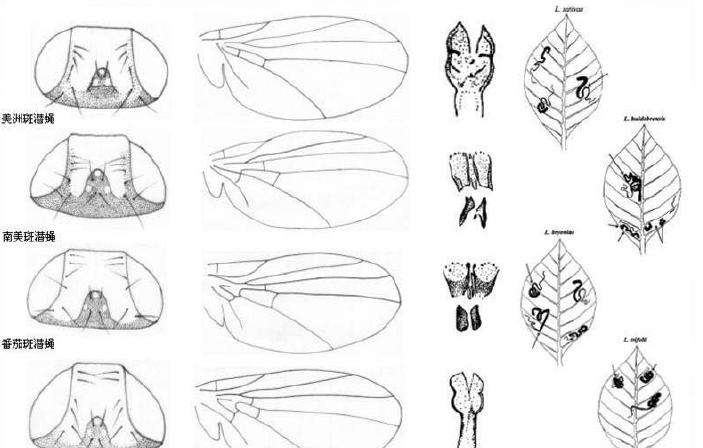Leafminer fly is an important pest on vegetables, mainly through the larvae moth to eat the host leaves, resulting in irregular insect tract, some female adults can also stab the host leaves and feed, not only affect the photosynthesis of plants, but also seriously reduce the yield of various crops, and even lead to harvest failure.
<h1 class="pgc-h-arrow-right" > several typical representatives of leafminer flies</h1>
(1) Among the invasive species, it mainly includes American spotted diving fly, South American spotted diving fly, clover spotted diving fly and tomato spotted diving fly.

Several identifying features of the invasive spotted fly
Note: From left to right, the head, wing veins, male external genitalia, and lesions are drawn by Teacher He Yating.
American spotted fly: adults, larvae can be harmful, adult insects in the front of the leaf to feed and lay eggs, larvae from the front of the leaf to dive into the leaf and petiole hazard, the epidermis of the leaf appears typical snakewalker road, generally do not pass through the leaf veins, like nightshade, legumes, cucurbitaceae and Asteraceae, etc., can not be harmful to grasses.
South American spotted diving fly: adult insects use egg layers to lay eggs in the leaves, hatched larvae on the leaves, between the epidermis submerged leaf flesh, the worm tract is thick and wide, often blocky, incoherent, the host range is wide, like legumes, cucurbitaceae, solanaceae, Asteraceae, Amaranthaceae and so on.
Tomato spotted fly: adults feed and lay eggs on the front of the leaf, stab leaf cells, larvae hatch and dive into leaf flesh, showing a meandering feeding mark, the worm path can pass through the leaf veins, there are black strips of feces distributed in it, the host range is narrow, mainly occurring on nightshade crops.
Clover spotted fly: the worm's path is irregularly linearly stretched in the upper epidermis, the terminal is not significantly widened, and it loves Asteraceae, Cucurbitaceae, Legumes, Solanaceae, etc., of which parsley is its feeding host.
(2) Among the native species, there are mainly pea color diving flies and allium spotted diving flies.
Pea color diving fly
Allium-spotted flycatcher
Pea color diving fly: larvae in the leaf to feed the leaf flesh, resulting in a spiral bending of the diving channel, resulting in leaf wilting, more tolerant to low temperatures, in the cruciferous crop is more harmful.
Allium spotted fly: Larvae on the leaves of allium vegetables as a pest, the insect road is yellow and white, is continuous, and relatively straight, mainly harmful to green onions, leeks, onions, garlic and other lily family of allium vegetable plants, with green onions the most seriously affected.
<h1 class= "pgc-h-arrow-right" > hazard characteristics of leafminer flies</h1>
(1) Wide range of feeding: for example, the American spotted diving fly can harm more than 110 kinds of host plants in 22 families, and the host plants that have been found in the South American spotted diving fly are as high as 39 families and 287 species.
(2) Strong reproductive ability: leafminer flies have a high amount of eggs, a short development period, and eggs are not easily damaged inside the leaves.
(3) Poor chemical prevention effect: Due to the harmful characteristics of leaf diving fly "submerged channel", the efficiency of chemical drug prevention and control is low. And the use of a large number of chemical pesticides not only has a unsatisfactory effect, but also increases pesticide residues, kills natural predators, and also makes leafminer flies resistant.
< h1 class = "pgc-h-arrow-right" > the comprehensive control of leafminer flies</h1>
Agricultural control: clean the countryside, timely deal with the stubble and dead leaves, eradicate weeds, concentrate them in deep burial or fertilizer, reduce the number of adult insect feathers in the vegetable field; rationally arrange stubble, interspersed with planting non-food-loving plants to dismantle bridges and break generations; after vegetable harvest, clear the garden to plough, eliminate insect pupae, protected land combined with high temperature and stuffy shed.
Physical control: laying insect nets; hanging yellow plates or rubber strips sticking flies; mild artificial pinch killing.
Biological control: Protect and utilize natural predators, such as Ji Xiao Wasp, Golden Wasp, etc., and can be actively released by facility cultivation.
Pharmaceutical control: Due to the overlapping generations of leafminer flies, there is no obvious generation division, it is recommended to apply the drug for the first time at the peak of adult activity and the 1-2 instar stage of the larvae, and then spray it once every 7 to 10 days, for a total of 2 to 3 times. Agents can choose diaphragmamine, avermectin, cypermethrin, thiamethoxine and the like.
This article is written and sorted by the agricultural assistant team, please be sure to indicate the source of the agricultural assistant when reprinting. Do not modify the content of the article, the modification must be investigated!